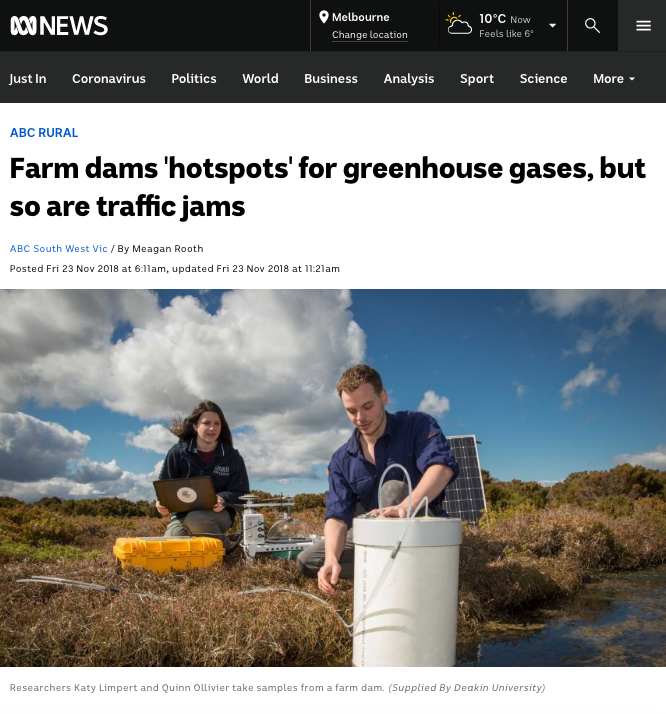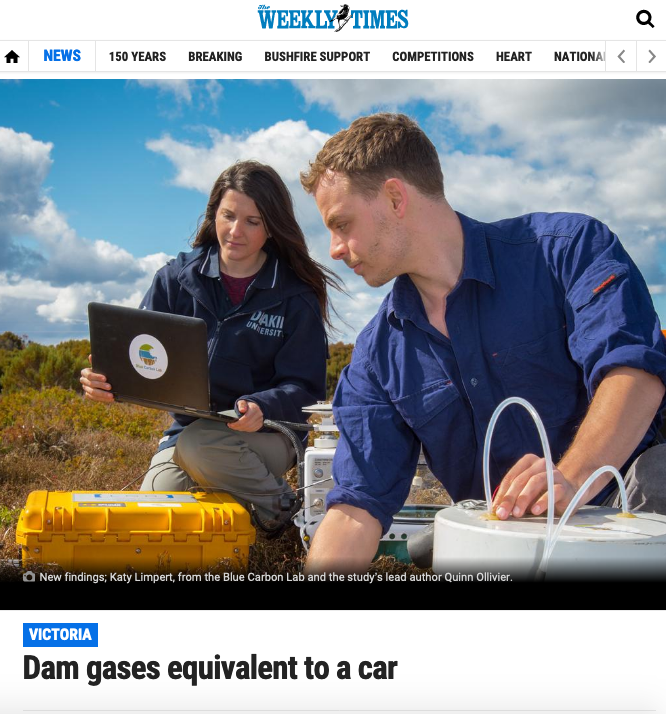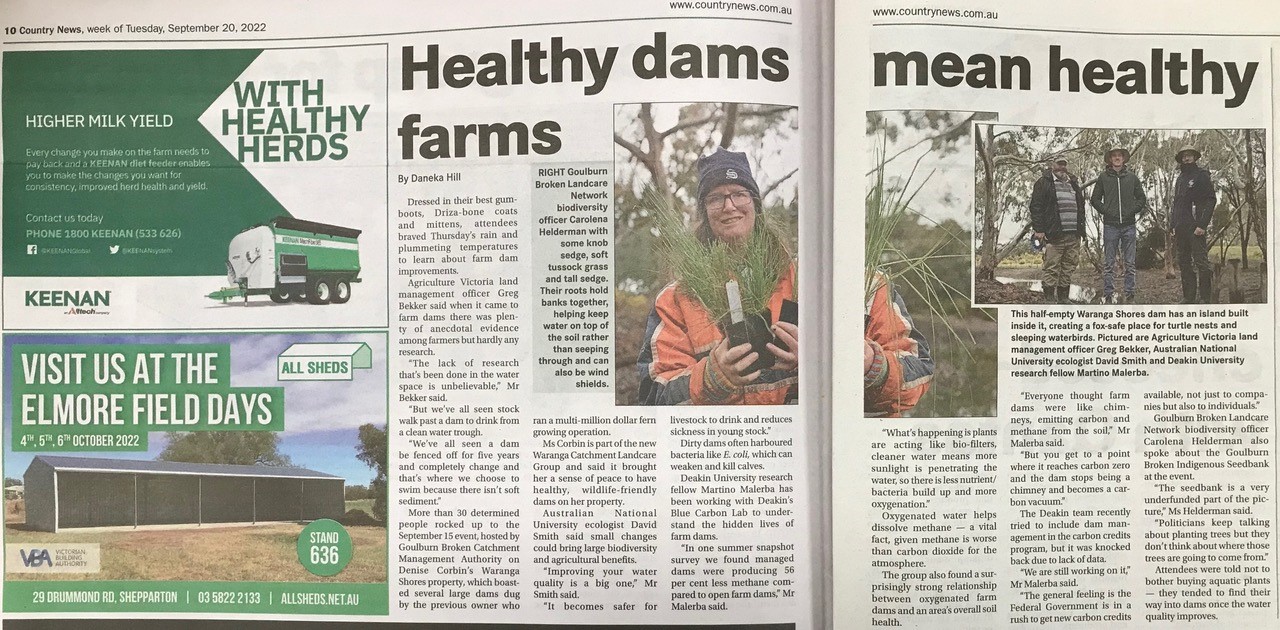AUSTRALIAN FARM DAMS
Farm dams are among the most abundant types of artificial waterbodies in Australia. Our multidisciplinary research team is exploring how managing farm dams can lower emissions, boost biodiversity, ensure water security, and improve community well-being.
Connect with us
Do you have a farm dam? Want to help our research?
Our team can organise a monitoring program (for free) to measure emissions, water quality and biodiversity. At the end of the study we will provide you with personalised metrics to improve your dam. Register your interest here.
Do you want to learn directly from our scientists?
Dr Martino Malerba (program leader) is open to presenting at community events about sustainable farm dam practices. Download the flyer here.
Do you want to join our research team?
We are seeking PhD candidates, interns and research assistants to join an ARC Discovery Early Career Research Award on this project! See our Opportunities page to learn more.
Selected publications
- Malerba, Martino E., et al. (2023) Conserving nature’s chorus: Local and landscape features promoting frog species richness in farm dams. Biological Conservation 286 : 110270.
- Malerba, M.E., Friess, D.A., Peacock, M., Grinham, A., Taillardat, P., Rosentreter, J.A., Webb, J., Iram, N., Al-Haj, A.N., Macreadie, P.I. (2022) Methane and nitrous oxide emissions complicate the climate benefits of teal and blue carbon wetlands. OneEarth. https://doi.org/10.1016/j.oneear.2022.11.003.
- Malerba, M.E., de Kluyver, T., Wright, N., Schuster, L., Macreadie, P.I. (2022). Methane emissions from agricultural ponds are underestimated in national greenhouse gas inventories. Nature Communications Earth & Environment. https://doi.org/10.1038/s43247-022-00638-9
- Malerba, M.E., Lindenmayer, D.B., Scheele, B.C., Waryszak, P., Yilmaz, I.N., Schuster, L., Macreadie, P.I. (2022). Fencing farm dams to exclude livestock halves methane emissions and improves water quality. Global Change Biology. https://doi.org/10.1111/gcb.16237
- Malerba, M.E., Wright, N., Macreadie, P.I. Australian farm dams are becoming less reliable water sources under climate change. Science of the Total Environment 2022, vol 829. https://doi.org/10.1016/j.scitotenv.2022.154360
- Malerba, M.E., Wright, N., Macreadie, P.I. A Continental-Scale Assessment of Density, Size, Distribution and Historical Trends of Farm Dams Using Deep Learning Convolutional Neural Networks. Remote Sens. 2021, 13, 319. https://doi.org/10.3390/rs13020319
- Ollivier, Q.R., Maher, D.T., Pitfield, C., Macreadie, P.I. Winter emissions of CO2, CH4 and N2O from temperate agricultural dams: fluxes, sources and processes. Ecosphere 2019. https://doi.org/10.1002/ecs2.2914
- Ollivier, Q.R., Maher, D.T., Pitfield, C., Macreadie, P.I. Punching above their weight: Large release of greenhouse gases from small agricultural dams. Global Change Biology 2018. DOI: 10.1111/gcb.14477
Selected media and outreach
- Fencing can reduce the risks of toxic water and improve livestock health (ABC News, Australia | April 2023)
- Researchers push for carbon credit payments for Australian farmers who fence their dams (ABC News, Australia | June 2022)
- Healthy dams mean healthy farms (Country News, September 2022)
- Webinar for ACT NRM Landcare & Waterwatch on managing farm dams to reduce carbon emissions, improving biodiversity & water security (Youtube, September 2022)
- Presentation at the South Gippsland Landcare Network on reducing greenhouse gas emissions from farm dams (Vimeo, June 2022)
- Aussie farm dams help cut greenhouse gases (7 News, Australia | January 2022)
- Presentation at Zero Emissions Farming Conference 2021 (Youtube | November 2021)
- Presentation for Deakin Centre for Integrative Ecology on Farm Dams (Youtube | November 2021)
- Farm dams hold secret of carbon capture (The Weekly Times, Australia | December 2021)
- Farm’s dam good place to cut carbon emissions: World-first study (Deakin Media Release, Australia | Nov 2018)
- Farm dams ‘hotspots’ for greenhouse gases, but so are traffic jams (ABC News, Australia | Nov 2018)
- Dam gases equivalent to a car (The Weekly Times, Australia | Nov 2018)
> Video produced by students of SLE200 (Communicating Science Ideas) at Deakin University: Lachlan Kelly, Natalia Sanchez, Joel Kermode, and Jake Maples.
> Video produced by Deakin Industry Student Capstone (DISC) SIT374/SIT782 ‘Environmental Science Squad T3 2021.
Funding & Program Partners
This program is run by Dr Martino Malerba from Deakin University’s Blue Carbon Lab.
The Australian Research Council funded this project through a DECRA fellowship awarded to Dr Malerba. Other partners include Corangamite Catchment Management Authority; Southern Cross University; Australian Govt – Dept. of Industry, Science, Energy and Resources; Govt of Western Australia – Department of Primary Industries and Regional Development, Sustainability and Biosecurity; Australian National University and Sustainable Farms.

This program is financially supported by funding provided by BHP.




